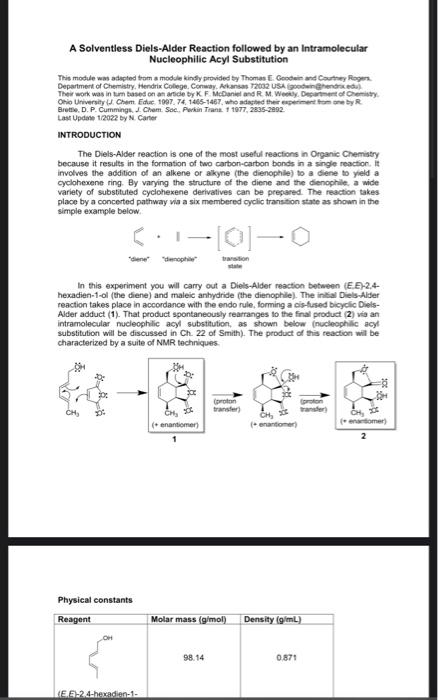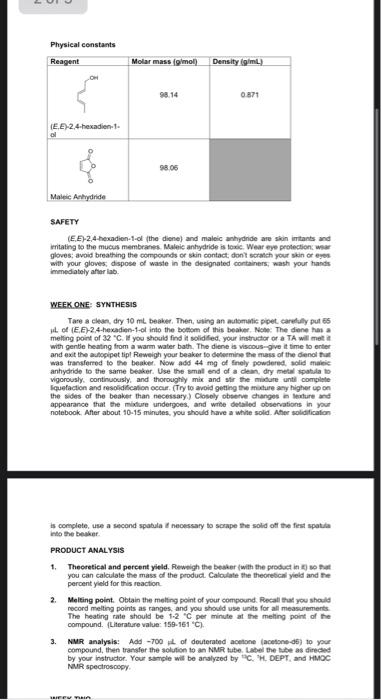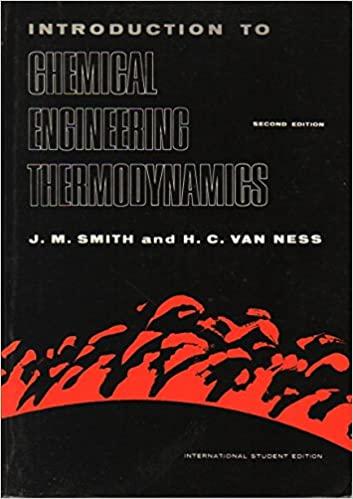



out a LE your Carry Diels-Alder, TEE-, ne kadi tn. - 9-o ethe dime) and malic anhydride (the dienophile). Also find the product Safety: CE, ES-2, 4 hexadien-tol (the diene) and maleic. sportenen I ) . anhydride mus are Skin irritants and imitating to the membranes maleic anhydride is toxic wear eye protection; wear gloves, avoid breathing the compounds or skin contents don't scratch your skin the designated containers, wish eyes with your gloves, dispose of waste in hands immediately after lab Observations Procedure 1. Tared a clean, dry loml/mass of beaker 8.071g beaker of beaker with howed an automatic pipet mot heden tol: 81629 and 1-24 hexadient-ol into beaker mass of CE,E)-2, 4 horadiantol 3. Reweighed beaker to 0.041g determine mass of diend 4.95 mg of finely 10.095g) powdered, solid malbic anhydride to the same beaker yellow liquid at first with 5. used small end of a Some fine pandor clean, dry metal spatula to Vigoranly mix and continuously, Became a little more yellow and with clumps Stir the mixture until - Became more liquidy liqueraction and resoldification - Turned into a oors Solid 6. changes in -Turned a white texture and appearance yellow solingo 1. mussed weight product mass of watchglass 48.531g. 8. Crushed product with mass of watchglass with product and added 48.6759 Imass of product 0.1499 9. Obtained melting point melting range Tis2.1C - 158.7C of Sample clunky testing tube in sampling tube Date Witness/A Date Signature Note: Insert Divider Under Cooy Sheet Before Wisting THE HAYDEN-MCNEIL STUDENT LAB NOTEBOOK A Solventless Diels-Alder Reaction followed by an Intramolecular Nucleophilic Acyl Substitution This module was adopted from a module kindly provided by Thomas E Goodwin and Coutry Roger Department of Chemistry, Hendrix College. Conway. Abansas 2002 USA gehenedal The work was in tum based on an article by K F McDaniel and R M Wory Department of Chemistry Ohio Uniwersyu. Chem. Edhe 100774 145 1467, who adapted the permettono Brette. D.P. Cummings. Chem. Soc. Perkin Trana 1 1977,2835-2892 Last Update 1/2022 by N. Carter INTRODUCTION The Diels-Alder reaction is one of the most useful reactions in Organic Chemistry because it results in the formation of two carbon-carbon bonds in a single reaction it involves the addition of an alkene oralkyne (the dienophile) to a diene to yield a cyclohexene ring By varying the structure of the diene and the dienophile, a wide variety of substituted cyclohexene derivatives can be prepared. The reaction takes place by a concerted pathway via a six membered cyclic transition state as shown in the simple example below 6.1-10-0 transition In this experiment you will carry out a Diels-Alder reaction between (EE)-2,4- hexadien-1-ol (the diene) and maleic anhydride (the dienophile). The initial Diels-Alder reaction takes place in accordance with the endo rule, forming a cis-fused bicyclic Diels- Alder adduct (1). That product spontaneously rearranges to the final product 2) vian intramolecular nucleophilic acyl substitution, as shown below (nucleophilic acy! substitution will be discussed in Ch. 22 of Smith). The product of this reaction will be characterized by a suite of NMR techniques proto CH, tron & enantiomer (+ enantiomer (tomer Physical constants Reagent Molar mass (g/mol) Density (g/mL) OH 98.14 0.871 E.E-24-hewadien-1- Physical constants Reagent Molar mass (g/mol Density (gim.) $ 98.14 0.871 E.E) 2.4.hexadient. 98.06 Male Arhydride SAFETY (EE)-2.4 hexadien-1-of (the diene) and maleic anhydride are son imitants and irritating to the mucus membranes Maleic anhydride is to Wear eye protection sloves: avoid breathing the compounds or skin contact don't scratch your skin or eyes with your gloves, dispose of waste in the designated containers, wash your hands immediately after ab. WEEK ONE SYNTHESIS Tare schon, dry 10 ml beaker. Then, using an automatic pipet carefully put 65 lof (EE-24-hexadion-1-ot into the bottom of this beaker Note: The diene has a meling point of 32 C. you should find it solidfied, your instructor or a TA wil met with gentle heating from a warm water bath. The dienes viscous-givet time to enter and exit the autopipet tipl Reweigh your beaker to determine the mass of the denou was transferred to the besker. Now add 44 mg of finely powdered solid maleic anhydride to the same beaker. Use the small end of a candy metal spatula vigorously continuously, and thoroughly mix and stir the more until complete lquefaction and resolidification occur. (Try to avoid getting the mature any higher up on the sides of the beaker than necessary) Closely observe changes in Westure and appearance that the mixture undergoes, and write detailed observations in your notebook After about 10-15 minutes, you should have a white sold. After solidification complete, use a second spatula necessary to scrape the sold off the fest spada into the besker PRODUCT ANALYSIS 1. Theoretical and percent yield. Reweigh the beaker with the product in the you can calculate the mass of the product Calculate the theoretical yield and the percent yield for this reaction 2. Melting point. Obtain the melting point of your compound. Recall that you should record melting points as ranges, and you should use units for all measurements The heating rate should be 1-2 C per minute at the melting point of the compound Literature value: 159-161 C). 3. NMR analysis: Add-700 of deuterated acetone (acetone-05) to you compound, then transfer the solution to an NMR tube Label the tube as directed by your instructor. Your sample will be analyzed by C. H DEPT and HMOC NMR spectroscopy LIFEYRI POST LAB QUESTIONS- Use the form in the Lab Materials section of Blackboard to submit your answers. Upload pdf images only. 1. Upload your notebook pages as one pdf file 2. Calculate the theoretical and percent yield for the reaction product. Your calculations must be neat and show all units, chemical names, and use significant figures correctly Upload your answer in pdf format 3. Discuss the yield of the product. Explain how product may have been lost and, applicable, how the yield might be improved. 4. Determine the percent atom economy for the reaction. Enter your answer without a percentage symbol. For example, if your answer is 50.0% just enter 50.0. 5. Discuss the purity of your product based upon the melting point range you measured. 6. Evaluate the purity of your product based upon your " and "C NMR spectra. Is any unreacted diene or dienophile present? 7. List two ways that this reaction can be described as "green" 8. Assign the peaks in the 'H NMR spectrum of the product by writing the appropriate letter above the peak directly on your spectrum. You do not need to differentiate protons land , just label the two appropriate peaksi). The peak for proton his so broad you will likely not be able to assign it Upload your labeled spectrum in pdf format. c 10 9. Assign the peaks in the C NMR spectrum of the product by writing the appropriate letter above the peak directly on your spectrum. You do not need to differentiate carbonst and s. just label the two appropriate peaks ts. Upload your labeled spectrum in pdf format n m OM out a LE your Carry Diels-Alder, TEE-, ne kadi tn. - 9-o ethe dime) and malic anhydride (the dienophile). Also find the product Safety: CE, ES-2, 4 hexadien-tol (the diene) and maleic. sportenen I ) . anhydride mus are Skin irritants and imitating to the membranes maleic anhydride is toxic wear eye protection; wear gloves, avoid breathing the compounds or skin contents don't scratch your skin the designated containers, wish eyes with your gloves, dispose of waste in hands immediately after lab Observations Procedure 1. Tared a clean, dry loml/mass of beaker 8.071g beaker of beaker with howed an automatic pipet mot heden tol: 81629 and 1-24 hexadient-ol into beaker mass of CE,E)-2, 4 horadiantol 3. Reweighed beaker to 0.041g determine mass of diend 4.95 mg of finely 10.095g) powdered, solid malbic anhydride to the same beaker yellow liquid at first with 5. used small end of a Some fine pandor clean, dry metal spatula to Vigoranly mix and continuously, Became a little more yellow and with clumps Stir the mixture until - Became more liquidy liqueraction and resoldification - Turned into a oors Solid 6. changes in -Turned a white texture and appearance yellow solingo 1. mussed weight product mass of watchglass 48.531g. 8. Crushed product with mass of watchglass with product and added 48.6759 Imass of product 0.1499 9. Obtained melting point melting range Tis2.1C - 158.7C of Sample clunky testing tube in sampling tube Date Witness/A Date Signature Note: Insert Divider Under Cooy Sheet Before Wisting THE HAYDEN-MCNEIL STUDENT LAB NOTEBOOK A Solventless Diels-Alder Reaction followed by an Intramolecular Nucleophilic Acyl Substitution This module was adopted from a module kindly provided by Thomas E Goodwin and Coutry Roger Department of Chemistry, Hendrix College. Conway. Abansas 2002 USA gehenedal The work was in tum based on an article by K F McDaniel and R M Wory Department of Chemistry Ohio Uniwersyu. Chem. Edhe 100774 145 1467, who adapted the permettono Brette. D.P. Cummings. Chem. Soc. Perkin Trana 1 1977,2835-2892 Last Update 1/2022 by N. Carter INTRODUCTION The Diels-Alder reaction is one of the most useful reactions in Organic Chemistry because it results in the formation of two carbon-carbon bonds in a single reaction it involves the addition of an alkene oralkyne (the dienophile) to a diene to yield a cyclohexene ring By varying the structure of the diene and the dienophile, a wide variety of substituted cyclohexene derivatives can be prepared. The reaction takes place by a concerted pathway via a six membered cyclic transition state as shown in the simple example below 6.1-10-0 transition In this experiment you will carry out a Diels-Alder reaction between (EE)-2,4- hexadien-1-ol (the diene) and maleic anhydride (the dienophile). The initial Diels-Alder reaction takes place in accordance with the endo rule, forming a cis-fused bicyclic Diels- Alder adduct (1). That product spontaneously rearranges to the final product 2) vian intramolecular nucleophilic acyl substitution, as shown below (nucleophilic acy! substitution will be discussed in Ch. 22 of Smith). The product of this reaction will be characterized by a suite of NMR techniques proto CH, tron & enantiomer (+ enantiomer (tomer Physical constants Reagent Molar mass (g/mol) Density (g/mL) OH 98.14 0.871 E.E-24-hewadien-1- Physical constants Reagent Molar mass (g/mol Density (gim.) $ 98.14 0.871 E.E) 2.4.hexadient. 98.06 Male Arhydride SAFETY (EE)-2.4 hexadien-1-of (the diene) and maleic anhydride are son imitants and irritating to the mucus membranes Maleic anhydride is to Wear eye protection sloves: avoid breathing the compounds or skin contact don't scratch your skin or eyes with your gloves, dispose of waste in the designated containers, wash your hands immediately after ab. WEEK ONE SYNTHESIS Tare schon, dry 10 ml beaker. Then, using an automatic pipet carefully put 65 lof (EE-24-hexadion-1-ot into the bottom of this beaker Note: The diene has a meling point of 32 C. you should find it solidfied, your instructor or a TA wil met with gentle heating from a warm water bath. The dienes viscous-givet time to enter and exit the autopipet tipl Reweigh your beaker to determine the mass of the denou was transferred to the besker. Now add 44 mg of finely powdered solid maleic anhydride to the same beaker. Use the small end of a candy metal spatula vigorously continuously, and thoroughly mix and stir the more until complete lquefaction and resolidification occur. (Try to avoid getting the mature any higher up on the sides of the beaker than necessary) Closely observe changes in Westure and appearance that the mixture undergoes, and write detailed observations in your notebook After about 10-15 minutes, you should have a white sold. After solidification complete, use a second spatula necessary to scrape the sold off the fest spada into the besker PRODUCT ANALYSIS 1. Theoretical and percent yield. Reweigh the beaker with the product in the you can calculate the mass of the product Calculate the theoretical yield and the percent yield for this reaction 2. Melting point. Obtain the melting point of your compound. Recall that you should record melting points as ranges, and you should use units for all measurements The heating rate should be 1-2 C per minute at the melting point of the compound Literature value: 159-161 C). 3. NMR analysis: Add-700 of deuterated acetone (acetone-05) to you compound, then transfer the solution to an NMR tube Label the tube as directed by your instructor. Your sample will be analyzed by C. H DEPT and HMOC NMR spectroscopy LIFEYRI POST LAB QUESTIONS- Use the form in the Lab Materials section of Blackboard to submit your answers. Upload pdf images only. 1. Upload your notebook pages as one pdf file 2. Calculate the theoretical and percent yield for the reaction product. Your calculations must be neat and show all units, chemical names, and use significant figures correctly Upload your answer in pdf format 3. Discuss the yield of the product. Explain how product may have been lost and, applicable, how the yield might be improved. 4. Determine the percent atom economy for the reaction. Enter your answer without a percentage symbol. For example, if your answer is 50.0% just enter 50.0. 5. Discuss the purity of your product based upon the melting point range you measured. 6. Evaluate the purity of your product based upon your " and "C NMR spectra. Is any unreacted diene or dienophile present? 7. List two ways that this reaction can be described as "green" 8. Assign the peaks in the 'H NMR spectrum of the product by writing the appropriate letter above the peak directly on your spectrum. You do not need to differentiate protons land , just label the two appropriate peaksi). The peak for proton his so broad you will likely not be able to assign it Upload your labeled spectrum in pdf format. c 10 9. Assign the peaks in the C NMR spectrum of the product by writing the appropriate letter above the peak directly on your spectrum. You do not need to differentiate carbonst and s. just label the two appropriate peaks ts. Upload your labeled spectrum in pdf format n m OM










